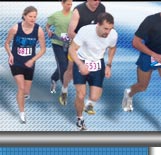

2003; 2002; 2001;
2000; 1999; 1998;
1997; 1996; 1995;
1994; 1993; 1992;
1991; 1990; 1989;
1988
About The River to River Relay
The Mississippi and Ohio rivers meet at the southern tip of Illinois. Between the two rivers lies a land quite unlike the rest of the state. Rolling hills covered with forests create an environment that is perfect for outdoor sports of all kinds.
Every April over two thousand runners cross this land between the rivers in the River to River Relay. It is not easy to describe the relay to someone who has never participated. It can be exhilarating, exhausting, intimidating, inspiring, and unforgettable, but adjectives alone are insufficient. For participants and organizers, the race is a succession of memorable images that last for a long time.
It is waking at 4 a.m. to get to the start on time and following a convoy of vehicles through the pre-dawn darkness. It is watching mist rise above the forest as the sun rises. It is marveling that two thousand runners and three hundred vehicles can travel eighty miles on back-country roads without someone losing the way.
A small band of people, lead-off runners on each team, admire a misty view of the Mississippi River valley from atop Pine Hills Bluff. Runners who have reached an exchange and earned a rest notice the beauty of redbud trees, or pause to admire the scenery. Running up a hill is made worthwhile by the view from the top.
It is two teams of fine runners battling each other for seven hours, the outcome in doubt until the last mile or so. It is a team of enthusiastic first-time runners who have trained for a year, who are given no chance of finishing by many of their acquaintances, struggling to complete the course before sunset. It is elite runners and recreational joggers running harder than they have ever run before because their team depends on them.
Residents of small towns and villages, not quite understanding what is going on, wave or pass water to tired runners as they go by, and a group of Canadian runners swap gifts with school band members in a small town. Visitors from across the Midwest exchange greetings with the inhabitants of rural southern Illinois.
Hundreds of volunteers, most of whom never see another race, give up a large part of their day to direct traffic or monitor exchanges. They return every year because it is so much fun. They tolerate the frustration of sorting out traffic snarls, and wonder why runners must stand in the middle of a busy road.
Race officials cope with problems that never seem to afflict organizers of ordinary races: bridges that disappear a week before the race, combine harvesters that occupy the full width of the road, and farm animals that stroll along the course or wallow in a ford.
The relay is the equivalent of three hard races in one day. Runners recover as best they can while other team members take a turn, encountering mud, hills, dust, hills, sweat, hills... They learn to welcome the cramped quarters of a vehicle occupied by seven other muddy, dusty, sweaty, tired people, and wonder why they were picked to tackle the terrible hill on section 22. The euphoria on reaching the finish line at the Ohio River, running in together as a team, resolves all the doubt.
The relay is a team sport for runners, who are often a very solitary lot. It is a chance to race, and then watch others race while driving between exchanges or waiting to receive the baton. It is sharing experiences with members of other teams, or trading friendly insults with the opposition.
The River to River Relay is a unique running experience: one part strenuous effort and seven parts recovery and relaxation. It might be a prescription for life.